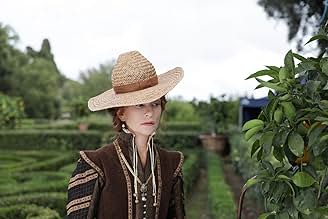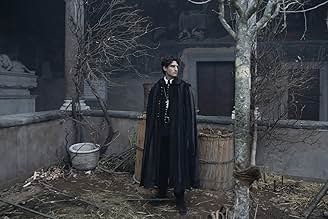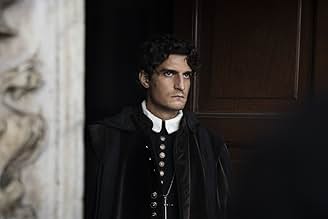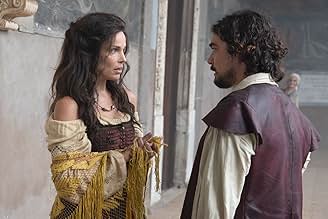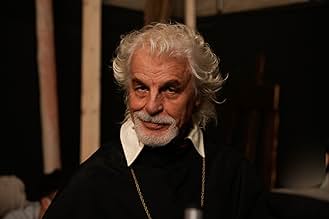L'ombra di Caravaggio
- 2022
- 2h
CALIFICACIÓN DE IMDb
6.5/10
1.8 k
TU CALIFICACIÓN
La Iglesia católica investiga en secreto a Caravaggio mientras el Papa sopesa si concederle clemencia por matar a un rival.La Iglesia católica investiga en secreto a Caravaggio mientras el Papa sopesa si concederle clemencia por matar a un rival.La Iglesia católica investiga en secreto a Caravaggio mientras el Papa sopesa si concederle clemencia por matar a un rival.
- Premios
- 16 premios ganados y 6 nominaciones en total
- Dirección
- Guionistas
- Todo el elenco y el equipo
- Producción, taquilla y más en IMDbPro
Argumento
¿Sabías que…?
- TriviaRiccardo Scamarcio said about Caravaggio's character: "I immediately thought that [Caravaggio] was like Elvis Presley. My reference was Elvis. A small-town boy with great energy, passion, talent and rigor towards art. At that time, painting was the mainstream, there was nothing else, there was no photography, there was no radio, television or cinema. Paintings were so powerful because they spoke directly to the unconscious. And this man was the first to represent sacred images in a completely different way."
- ErroresTodas las entradas contienen spoilers
Opinión destacada
A decent but no notable retelling of the life of the celebrated 17th-century painter through his brilliant, nearly blasphemous paintings and his flirtations with the underworld. Caravaggio proceeded to develop a new style of painting giving a more realistic view of the world in which he lived. He also begins love affairs with his models, and relations with lower life people: prostitutes, hobos , beggars, street fighters, and robbers. Their relationship leads to murder and deceit. After fleeing Rome accused of murder, Caravaggio takes refuge in Naples, under the protection of the Colonna family, there he awaits a possible absolution from Pope Paul V. Caravaggio proceeded to develop a new style of painting giving a more realistic view of the world in which he lived. When Pope awares Carvaggio (Riccardo Scamarcio) uses bad-life women, thieves and vagabonds as models for his religious works, he orders to investigate him secretly. For this reason, an inquisitor (Louis Garrel) is sent to find him and interrogate him, as the Pope weighs whether to grant him clemency for killing a rival. Along the way, Caravaggio is protected by aristocrat Costanza Sforza Colonna (Isabelle Huppert) . Following some sad events, Caravaggio stayed a few more months in Naples and finally left for Malta, the seat of the Knights of Malta. It is believed that his trip was sponsored by Alof de Wignacourt, Grand Master of the Order. De Wignacourt was so pleased with the painter's work that he proposed him as a candidate for the Order. In 1608 the painter was named a knight of grace and devotion of the Sovereign Military and Hospitaller Order of Saint John of Jerusalem, of Rhodes and of Malta.
The film is acceptable and passable but it gets bogged down in the darkest, most critical and painful moments of the painter's life, which is why it is somewhat unsympathetic and unpleasant to watch. Thus, the movie recreates a multitude of sexual moments, orgies, murders, with a lot of dirty and ugly characters, describing dark, impious people or evil inquisitors. Although Caravaggio's life could have developed in this way, it is not necessary to recreate his life so dark and creepy. See instead the example of the much better biography of Michelangelo: ¨The Agony and the Ecstasy¨ by Carol Reed with Charlton Heston, which despite being much longer was much more entertaining, bright and enjoyable to watch. And that is even though Michelangelo also lived a life in poverty and related to people of all social classes, especially the lower classes, and also suffered persecution.
The protagonist Riccardo Scamarcio, who gives adequate acting, is well accompanied by an international cast of known actors, such as: Isabelle Huppert (Elle) and Louis Garrel (Little Women), the latter plays the role of the Vatican emissary in charge of investigating what is hidden behind his works. The motion picture was mediocrely directed by Michele Placido.
Caravaggio captured close anatomical observation with a dramatic use of chiaroscuro that came to be known as tenebrism. This technique became a dominant stylistic element, darkening shadows and transfiguring objects into brilliant shafts of light. He vividly expressed crucial moments and scenes, often involving violent struggles, torture and death. He worked quickly from life models, eschewing sketches to work directly on canvas. His influence was profound on the new Baroque style that emerged from Mannerism and can be traced in the works of such great masters as Peter Paul Rubens, José de Ribera, Rembrandt and Diego Velázquez. His pictorial work was immense (many of them appear in the film): Medusa, Love Victorious (1602) shows Cupid above all earthly powers: war, music, science, government. The Death of the Virgin, The Conversion of Saint Paul on the Road to Damascus, Seven Works of Mercy, Saint Jerome Writing, The Flagellation of Christ, The Beheading of Saint John the Baptist (the only painting by Caravaggio with his signature). The Burial of Saint Lucy, The Raising of Lazarus and The Adoration of the Shepherds. And Portrait of the Grand Master of the Order of Malta Alof de Wignacourt, as well as portraits of other knights of the Order.
There are various biographic adaptations: 1941 ¨Caravaggio¨ directed by Goffredo Alessandrini, produced by Elica Film.1986 ¨Caravaggio¨ directed by Derek Jarman, with Nigel Terry, Sean Bean, Dexter Fletcher, Spencer Leigh, Tilda Swinton, Michael Gough. 2007 ¨Caravaggio The Shadow of Genius¨, directed by Angelo Longoni, produced by Ida di Benedetto and Stefania Bifano, for Titania Produzioni, two-part television miniseries. 2018 ¨Caravaggio - The Soul and the Blood¨ directed by Jesus Garces Lambert.
The film is acceptable and passable but it gets bogged down in the darkest, most critical and painful moments of the painter's life, which is why it is somewhat unsympathetic and unpleasant to watch. Thus, the movie recreates a multitude of sexual moments, orgies, murders, with a lot of dirty and ugly characters, describing dark, impious people or evil inquisitors. Although Caravaggio's life could have developed in this way, it is not necessary to recreate his life so dark and creepy. See instead the example of the much better biography of Michelangelo: ¨The Agony and the Ecstasy¨ by Carol Reed with Charlton Heston, which despite being much longer was much more entertaining, bright and enjoyable to watch. And that is even though Michelangelo also lived a life in poverty and related to people of all social classes, especially the lower classes, and also suffered persecution.
The protagonist Riccardo Scamarcio, who gives adequate acting, is well accompanied by an international cast of known actors, such as: Isabelle Huppert (Elle) and Louis Garrel (Little Women), the latter plays the role of the Vatican emissary in charge of investigating what is hidden behind his works. The motion picture was mediocrely directed by Michele Placido.
Caravaggio captured close anatomical observation with a dramatic use of chiaroscuro that came to be known as tenebrism. This technique became a dominant stylistic element, darkening shadows and transfiguring objects into brilliant shafts of light. He vividly expressed crucial moments and scenes, often involving violent struggles, torture and death. He worked quickly from life models, eschewing sketches to work directly on canvas. His influence was profound on the new Baroque style that emerged from Mannerism and can be traced in the works of such great masters as Peter Paul Rubens, José de Ribera, Rembrandt and Diego Velázquez. His pictorial work was immense (many of them appear in the film): Medusa, Love Victorious (1602) shows Cupid above all earthly powers: war, music, science, government. The Death of the Virgin, The Conversion of Saint Paul on the Road to Damascus, Seven Works of Mercy, Saint Jerome Writing, The Flagellation of Christ, The Beheading of Saint John the Baptist (the only painting by Caravaggio with his signature). The Burial of Saint Lucy, The Raising of Lazarus and The Adoration of the Shepherds. And Portrait of the Grand Master of the Order of Malta Alof de Wignacourt, as well as portraits of other knights of the Order.
There are various biographic adaptations: 1941 ¨Caravaggio¨ directed by Goffredo Alessandrini, produced by Elica Film.1986 ¨Caravaggio¨ directed by Derek Jarman, with Nigel Terry, Sean Bean, Dexter Fletcher, Spencer Leigh, Tilda Swinton, Michael Gough. 2007 ¨Caravaggio The Shadow of Genius¨, directed by Angelo Longoni, produced by Ida di Benedetto and Stefania Bifano, for Titania Produzioni, two-part television miniseries. 2018 ¨Caravaggio - The Soul and the Blood¨ directed by Jesus Garces Lambert.
- ma-cortes
- 6 ago 2024
- Enlace permanente
Selecciones populares
Inicia sesión para calificar y agrega a la lista de videos para obtener recomendaciones personalizadas
- How long is Caravaggio's Shadow?Con tecnología de Alexa
Detalles
Taquilla
- Presupuesto
- EUR 12,261,966 (estimado)
- Total a nivel mundial
- USD 4,832,241
- Tiempo de ejecución2 horas
- Color
- Relación de aspecto
- 2.39 : 1
Contribuir a esta página
Sugiere una edición o agrega el contenido que falta

Principales brechas de datos
By what name was L'ombra di Caravaggio (2022) officially released in India in English?
Responda
